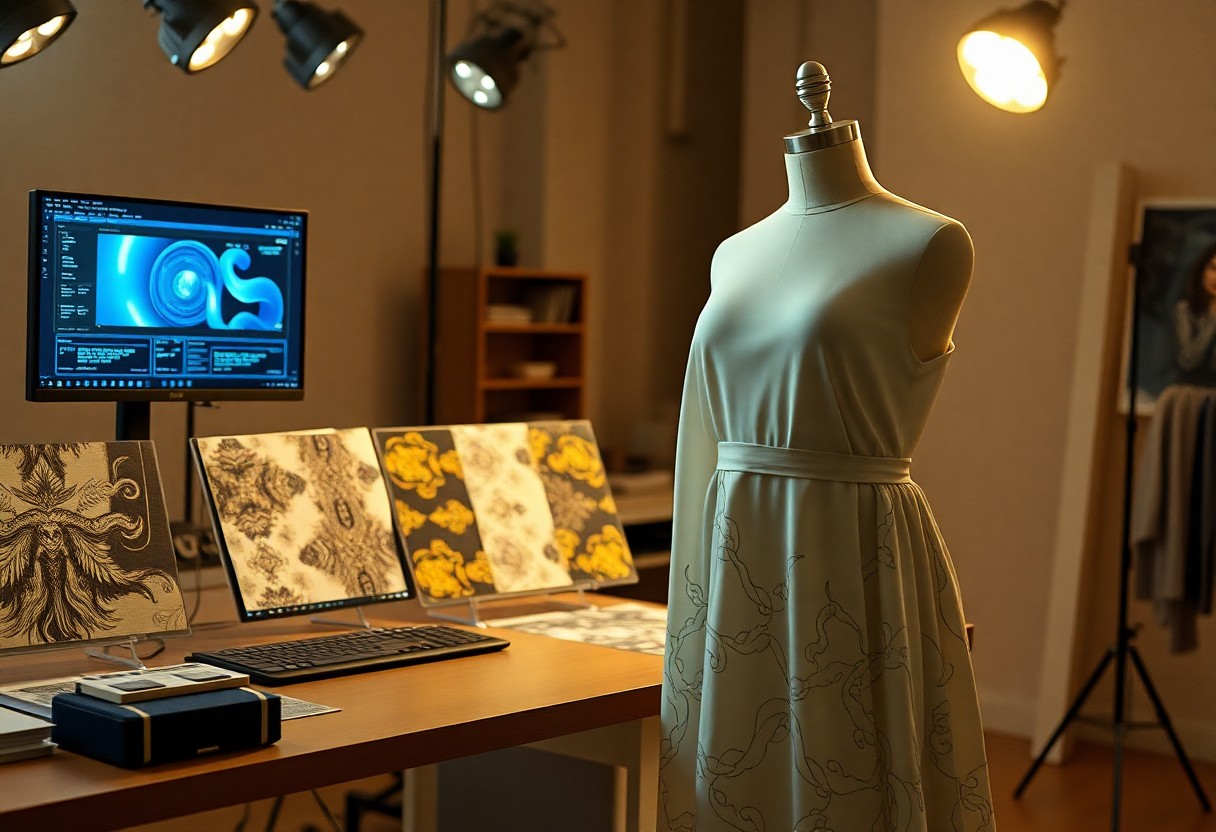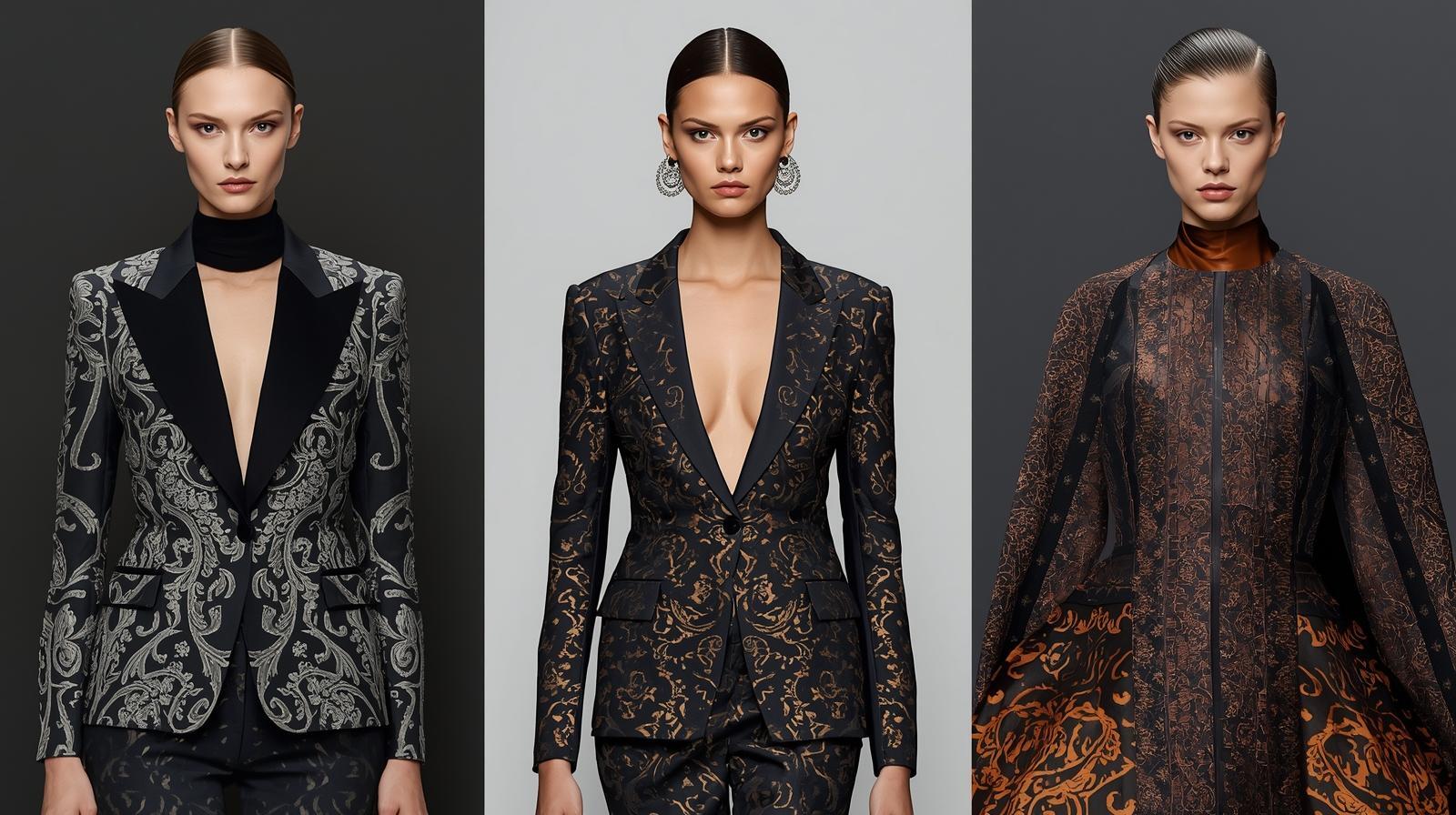30th Sep 2025
Digital Draping - How AI-Generated Prints Are Shaping the Runway

There's a transformative shift happening in fashion as AI-generated prints redefine how you perceive and interact with design. By utilizing digital draping techniques, designers can create innovative, custom prints that enhance your runway experience and expand creative possibilities. This technology streamlines the design process and allows for a more sustainable approach, minimizing waste and maximizing creativity. As you explore these advancements, consider how AI is not just influencing aesthetics but also pushing the boundaries of fashion itself.
Understanding Digital Draping
Definition and Overview
Digital draping refers to the use of advanced software to simulate the behavior of fabric on virtual garments. This technique allows designers to visualize how different textiles will drape, move, and interact, reducing reliance on physical prototypes. By leveraging AI-generated prints, you can experiment with a vast array of patterns and colors, ultimately creating innovative designs that resonate with contemporary aesthetics.
Historical Context
Digital draping is rooted in traditional garment construction but has rapidly evolved with technological advancements. Initially, fashion design relied heavily on manual sketches and physical fabric samples, making the process time-consuming and less flexible. The introduction of CAD (Computer-Aided Design) in the 1980s marked a pivotal moment, allowing for more precise digital representations. As technology progressed, software that mimicked fabric properties emerged, enabling designers to integrate AI capabilities, thus revolutionizing the industry.
During the early 2000s, as computing power and graphic software improved, digital draping gained traction within the fashion industry. Noteworthy platforms such as CLO 3D and Optitex allowed designers to create virtual collections and conduct fittings without the need for physical garments. This shift not only accelerated the design process but also enhanced sustainability by minimizing fabric waste. By 2023, the trend has solidified into a critical tool for modern fashion houses, combining artistry with groundbreaking technology.
The Role of AI in Fashion Design
Your approach to fashion design evolves as AI technology becomes an indispensable tool for many designers. By leveraging AI, you can enhance creativity, streamline processes, and assess consumer trends. From generating unique patterns to predicting style shifts, AI serves not just as an assistant, but as a collaborator in realizing your vision.
Machine Learning Algorithms
Machine learning algorithms play a pivotal role in transforming raw data into actionable insights. Through the analysis of vast datasets, including consumer preferences, fashion history, and trend forecasts, these algorithms help you make informed design choices. The result is a product tailored to market demands before it ever reaches the runway.
Creative Potential of AI
AI's creative potential offers you an unprecedented avenue for innovation within fashion design. By generating complex patterns and prints, it allows you to explore styles outside traditional boundaries. This technology empowers you to experiment with countless combinations quickly, enabling rapid prototyping and fostering unique design outcomes.
AI's creative potential extends beyond mere replication of existing styles; it invites you to discover entirely new aesthetics. For instance, designers like Balenciaga and Stella McCartney have successfully used AI to create prints that challenge conventional fashion norms, seamlessly blending art and technology. With tools capable of analyzing public sentiment and historical references, you can ideate and iterate effectively, giving rise to collections that resonate deeply with consumers while maintaining an air of originality and forward-thinking design. Your fashion work not only reflects the current trends but also pushes the envelope toward future possibilities.

Benefits of AI-Generated Prints
AI-generated prints bring significant advantages to the fashion industry, enhancing creativity, streamlining processes, and reducing time-to-market. With sophisticated algorithms analyzing trends and consumer preferences, you gain access to unique designs tailored to meet the ever-changing demands of the market. This technology not only elevates aesthetic appeal but also enriches the overall customer experience through personalization and customization.
Speed and Efficiency
Leveraging AI technology can dramatically increase speed and efficiency in the design process. Rapid generation of high-quality prints allows you to minimize waiting times typically associated with traditional design methods. Designs that might have taken weeks can now be produced in mere hours, enabling quicker turnaround times for collections and facilitating a more agile approach to fashion that responds effectively to trends.
Customization and Personalization
The potential for customization in AI-generated prints enables an unparalleled level of personalization for your clientele. Fashion brands can utilize algorithms to create tailor-made designs that resonate with individual customer preferences, offering them a unique product that reflects their personal style. This bespoke approach fosters deeper customer engagement, increasing brand loyalty and satisfaction.
For instance, AI platforms can analyze customer data to identify specific patterns and preferences, allowing you to generate designs that cater to niche markets or individual tastes. Imagine creating a line of prints that adjusts to size, color, and even seasonal trends based on customer insights. This level of customization not only enhances your product offering but also positions your brand as innovative and customer-centric, driving higher sales and fostering a stronger connection with your audience.
Case Studies: Successful Implementations
Multiple designers and brands have embraced AI-generated prints, showcasing innovative applications in the fashion industry. These case studies not only highlight creative possibilities but also illustrate the significant business impact of digital draping technologies.
- Balenciaga: Utilized AI to generate exclusive prints, leading to a 30% increase in online engagement and a 20% rise in sales for specific collections.
- Adidas: Integrated AI to create on-demand fabrics, reducing waste by 40% and cutting production time in half.
- Stella McCartney: Collaborated with AI platforms to design sustainable prints, enhancing customer satisfaction scores by 25%.
- Khaite: Implemented AI for a capsule collection that saw a 60% faster turnaround from concept to runway.
Notable Designers and Brands
Several leading designers and brands have pioneered the use of AI in fashion, transforming traditional processes. Issey Miyake and Burberry are known for their cutting-edge designs that blend creativity with technology, resulting in enhanced consumer interest and brand loyalty.
Impact on Fashion Shows
The introduction of AI-generated prints has revolutionized fashion shows, allowing for dynamic presentations that captivate audiences. These technologies enable real-time customization of garments, leading to unique runway experiences that reflect current trends and consumer preferences.
Fashion shows now feature digitally draped garments that can adapt live during presentations, enhancing visual storytelling. The ability to showcase various prints instantaneously allows designers to engage with the audience in unprecedented ways, driving home the narrative of innovation. Not only has the aesthetics changed, but the logistical aspect has improved; designers can reduce the environmental footprint by leveraging digital sampling, ultimately leading to a more sustainable approach to fashion. The future of runway shows lies in this fusion of technology and artistry, captivating audiences and pushing the boundaries of what is possible in modern design.

Challenges and Considerations
Implementing AI-generated prints in fashion faces several challenges, from ensuring quality control to navigating copyright issues. Designers must balance innovation with practical execution, as the transition from digital to physical can result in unexpected outcomes. Additionally, the steep learning curve of integrating AI technology into established workflows, which requires investment in training and tools, can deter smaller brands from fully embracing the trend.
Ethical Implications
AI-generated designs raise ethical questions surrounding ownership and originality. You might discover yourself pondering who truly owns the prints created by algorithms. Concerns about intellectual property theft and the potential for homogenization in fashion grow as designers rely on AI, challenging traditional notions of creativity and artistic expression.

Market Acceptance
Consumer acceptance plays a pivotal role in the adoption of AI-generated prints. Your hesitation to embrace digitally created fashion could stem from skepticism about its authenticity or quality. As brands like Balenciaga experiment with AI in their collections, the response illustrates a divided market; some enthusiasts applaud technological advancements, while others cling to traditional craftsmanship.
The acceptance of AI-generated prints in the marketplace is evolving, as seen in major fashion weeks where brands showcase innovative designs created through algorithms. Surveys indicate that about 48% of consumers are open to AI-enhanced fashion if it maintains quality and originality. The rise of tech-savvy younger generations who prioritize sustainability and uniqueness aligns well with AI's potential for rapid customization, gradually shifting attitudes. As more industry leaders adopt these methods, you may witness a broader shift in consumer perception, ultimately influencing what you choose to wear.
Future Trends in Digital Draping
The future of digital draping lies in the convergence of cutting-edge technology and sustainable practices. As designers increasingly adopt AI-generated prints, the industry will witness a shift towards enhanced customization options, enabling you to create unique, tailor-made pieces that reflect individual styles. This evolution will disrupt traditional manufacturing processes, allowing for on-demand production and minimized waste, setting a new standard for ethical fashion.
Innovations on the Horizon
Emerging technologies like augmented reality (AR) and virtual reality (VR) promise to reshape your shopping experience, allowing you to visualize AI-generated designs in real-time before purchasing. Real-time rendering tools will enable immediate alterations, ensuring each garment meets your specific preferences. These advancements will make fashion more accessible and personalized than ever.
Predictions for the Fashion Industry
By 2030, AI-driven design is expected to account for a significant portion of the fashion market, potentially reaching a valuation of over $200 billion. You can anticipate a landscape where collaboration between human creativity and machine intelligence is seamless, leading to faster fashion cycles and unprecedented levels of customization.
As the fashion industry integrates AI-generated prints, expect sustainability to gain momentum, focusing on reducing waste and encouraging responsible consumerism. You will see brands prioritizing sustainable materials, with around 50% of major labels likely adopting digital draping by the decade's end. Customization will also surge, enabling customers to influence designs directly and thus create unique items that resonate with their personal ethos, fostering a deeper connection between you and the garment. In this dynamic future, collaboration between technology and creative vision will ultimately redefine style standards and ethical practices in fashion.
Final Words
From above, AI-generated prints are transforming your runway experience by offering innovative designs and enhancing the creative process. As you embrace digital draping, you’ll notice how this technology allows for greater flexibility and personalization in fashion, enabling you to bring your visions to life with precision. The integration of AI not only streamlines production but also fosters a new era of creativity in textiles, ensuring that you stay at the forefront of fashion trends and artistic expression. Embracing AI in your designs guarantees a more dynamic and responsive approach to the ever-evolving world of fashion.
